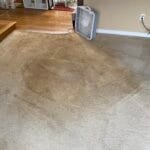Are you tired of staring at those unsightly holes and cracks in your walls or wooden furniture? You might be wondering whether to reach for wood filler or spackle to fix them.
Choosing the right product can be confusing, especially when you want a flawless finish that blends seamlessly with your décor. You’ll discover the key differences between wood filler and spackle, and learn which one is best suited for your specific repair needs.
Imagine the satisfaction of seeing your surfaces smooth and pristine once more. Keep reading, and you’ll be equipped with the knowledge to make the right choice, transforming your living space into a picture-perfect masterpiece.
Wood Filler Essentials
Wood filler and spackle serve different purposes in home improvement projects. Wood filler is perfect for repairing wooden surfaces, filling gaps and cracks. Spackle is ideal for fixing wall imperfections, ensuring smooth finishes before painting. Choose the right product based on your project’s needs and material type for best results.
Wood filler is an essential tool for anyone handling wood repairs. It helps in fixing holes, dents, and scratches on wooden surfaces. Understanding its composition and uses can guide your home repair projects.Composition And Types
Wood filler typically contains wood fibers or sawdust. These elements create a paste-like substance. Some fillers are water-based, others solvent-based. Water-based fillers dry quickly and are easy to clean. Solvent-based fillers offer a stronger bond. Choose based on the repair needs and wood type.Ideal Uses In Home Repairs
Wood filler works best for indoor wood surfaces. Use it for filling small to medium gaps, nail holes, and minor scratches. It’s suitable for repairing furniture, wooden floors, and trim. It’s not ideal for outdoor use unless sealed. Water exposure can weaken its bond.Advantages And Limitations
Wood filler offers a smooth finish. It’s easy to sand and paint over. This makes it blend well with existing woodwork. But it may not hold up under heavy stress. It can crack or shrink over time. It’s best for cosmetic repairs, not structural fixes. Always choose the right type for the job at hand.Spackle Basics
Choosing between wood filler and spackle depends on the task. Wood filler repairs holes and cracks in wood surfaces, offering a solid finish. Spackle, ideal for drywall, fills small gaps and dents, drying quickly for easy sanding and painting. Both materials serve distinct purposes in home repair projects.
Imagine you’re holding a wall painting party at your home, and a guest accidentally bumps into the wall, leaving a dent. Panic sets in, but wait—spackle might just be your new best friend! This versatile compound is often your go-to solution for repairing small holes and cracks in drywall. If you’ve ever wondered what’s inside that little tub of spackle, or how it’s different from wood filler, you’re in the right place. Let’s dive into the basics of spackle, where you’ll discover its ingredients, common uses, and weigh the pros and cons.Ingredients And Varieties
Spackle is typically made from a combination of gypsum powder and binders, creating a smooth paste. Some varieties may include acrylic or vinyl for extra durability. Most spackle comes pre-mixed, ready for immediate use—no fuss, no mess. You can also find lightweight versions, which are easier to apply and sand down. Quick-drying spackle is another option, perfect for those last-minute repairs before guests arrive. Which type do you think suits your needs best?Common Applications
Spackle shines in small repairs, like filling nail holes or minor dents. It’s the superhero of quick touch-ups, especially when you’re getting your home ready for sale. You can also use spackle for patching up minor drywall imperfections, bringing a seamless finish. Just apply, let it dry, and give it a light sanding before painting over. But remember, spackle isn’t designed for large gaps. For those, you might need a stronger compound.Pros And Cons
Pros: – Ease of Use: You don’t have to be a DIY expert. Anyone can apply spackle with a simple putty knife. – Speed: Dries quickly, letting you finish your project faster—perfect for tight schedules. – Versatility: Works well on various surfaces like drywall and plaster. Cons: – Limited Strength: Not suited for large repairs; it might crumble under pressure. – Surface Suitability: It’s not ideal for outdoor use, as it doesn’t hold up well against weather elements. – Shrinkage: Some types can shrink slightly as they dry, requiring multiple applications. Have you ever tried using spackle for a quick repair? Did you find it as easy as everyone claims? Share your thoughts in the comments below and let’s see if spackle deserves a spot in your DIY toolkit!Comparing Wood Filler And Spackle
Choosing the right product for patching holes or cracks can be tricky. Wood filler and spackle each serve distinct purposes, making them unique in their applications. Understanding their differences helps in making the right choice for your project.
Durability And Longevity
Wood filler is designed for woodworking projects. It expands and contracts with the wood. This makes it perfect for areas that experience temperature changes. It withstands wear and tear better than spackle. Spackle, on the other hand, is ideal for interior walls. It’s less durable and can crumble over time.
Ease Of Application
Applying wood filler requires some skill. It needs to be shaped and sanded after drying. This can make it a bit challenging for beginners. Spackle is easier to apply. It comes ready to use and dries quickly. This makes it perfect for those new to DIY.
Aesthetic Finish
Wood filler blends well with wood surfaces. It can be stained or painted to match surrounding areas. This ensures a seamless appearance. Spackle dries to a matte finish. It is best suited for painted walls. It doesn’t offer much flexibility in terms of aesthetics.

Credit: www.youtube.com
Choosing The Right Product
Choosing the right product between wood filler and spackle can be confusing. Each serves a unique purpose in home improvement projects. Understanding their differences helps you make an informed decision. Let’s explore key factors influencing your choice.
Project Type Considerations
Consider the project’s material when selecting a product. Wood filler works well on wooden surfaces. Spackle is ideal for drywall repairs. For outdoor projects, wood filler withstands weather better. Indoor projects might favor spackle for smooth finishes. Assess the surface and environment before deciding.
Budget And Availability
Budget plays a crucial role in product choice. Wood filler and spackle come in various price ranges. Higher-quality options may cost more but offer durability. Availability can affect your decision too. Local stores might stock one product more than the other. Compare prices and check availability in your area.
Environmental Factors
Think about environmental factors impacting your choice. Wood filler is often better for outdoor use. It resists moisture and temperature changes. Spackle suits indoor environments, providing a smooth finish. Consider the climate and exposure to elements where the repair will take place.
Tips For Successful Diy Repairs
Choose between wood filler and spackle based on repair needs. Wood filler suits large gaps and wooden surfaces. Spackle is ideal for small holes in walls. Understanding their uses ensures effective DIY repairs.
When tackling home repairs, choosing between wood filler and spackle can be a head-scratcher. Both are essential tools in the DIY arsenal, but understanding their differences is crucial for a successful project. Whether you’re patching up a wooden chair or smoothing out drywall, these tips will guide you to flawless finishes and sturdy repairs.Preparation And Safety
Before diving into any repair, ensure your workspace is clean and organized. Remove dust and debris from the area you plan to repair; this ensures the filler or spackle adheres properly. Wear safety goggles and a mask when sanding or mixing to protect yourself from dust particles. Always read the product instructions. Some fillers and spackles require mixing, while others are ready-to-use. Check for any additional safety precautions mentioned on the label, such as ventilation requirements.Techniques For Effective Use
When applying wood filler, use a putty knife to press it into the grain, filling gaps and holes completely. Smooth out the surface with the knife to ensure a flat finish once it dries. Let it cure fully before sanding. For spackle, use a similar approach but focus on applying thin layers. If you apply too much at once, it might crack as it dries. Multiple thin coats allow for better control and a smoother outcome.Common Mistakes To Avoid
Avoid rushing the drying process. It’s tempting to speed things up, but improper curing can lead to weak repairs. Be patient and let the material set as recommended. Don’t skip sanding. It might seem tedious, but sanding ensures a seamless blend with the surrounding surface. A quick swipe with fine-grit sandpaper can make all the difference. Ever tried to paint over a repair only to see it stand out like a sore thumb? That often happens when you skip priming. Priming after sanding helps the paint adhere evenly, making your repair invisible. Embrace these tips and watch your DIY projects transform into professional-looking repairs. Are you ready to choose the right product and refine your technique? Your home will thank you for it!
Credit: www.makingmanzanita.com

Credit: www.cncmasters.com
Frequently Asked Questions
What Is The Main Difference Between Wood Filler And Spackle?
Wood filler is for filling wood imperfections. Spackle is for repairing small holes in walls.
Can Wood Filler Be Used On Walls?
Wood filler is not ideal for walls. It is designed specifically for wood surfaces.
Is Spackle Suitable For Outdoor Use?
Spackle is not recommended for outdoors. It lacks weather resistance.
How Long Does Wood Filler Take To Dry?
Wood filler typically dries in 30 minutes. Drying time can vary based on thickness.
Can You Paint Over Spackle?
Yes, you can paint over spackle. Ensure it is fully dry before painting.
Conclusion
Choosing between wood filler and spackle depends on your project needs. Wood filler works best for outdoor or large wooden repairs. Spackle suits small indoor fixes and drywall imperfections. Consider the material and environment before deciding. Both products have their strengths.
Understanding each will ensure better results. Using the right product saves time and effort. Your repair job will look smooth and professional. Take time to assess your project requirements. Make an informed choice for the best outcome. Happy repairing!





